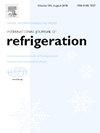基于消磁效应的固态磁制冷机
IF 3.5
2区 工程技术
Q1 ENGINEERING, MECHANICAL
International Journal of Refrigeration-revue Internationale Du Froid
Pub Date : 2025-07-05
DOI:10.1016/j.ijrefrig.2025.06.022
引用次数: 0
摘要
随着人口增长、生活方式的改变和全球变暖,对生态和低能耗技术的需求急剧上升。磁制冷是传统制冷的一种很有前途的替代品。然而,仍有几个因素影响其性能,从而推迟商业化。使用热管理元件(如热开关)代替热流体进行热传递可以避免由传导/对流、流体振荡和机械摩擦引起的一些主要问题。此外,旋转磁热效应可以有效地解决该技术中常见的退磁问题。因此,本文提出并数值模拟了一种基于旋转磁热效应的新型固态磁制冷机,该旋转磁热效应是由磁热学材料板在恒定磁场下交替旋转产生的。该器件的性能随着磁热材料板的纵横比的减小而提高,最大空载温度跨度为2.02 K。不对称循环的实现可以在温度范围内提高30%,这弥补了未来应用中低强度磁场的使用。这种创新和紧凑的模型使基于旋转磁热效应的新型磁性冰箱的发展成为可能。本文章由计算机程序翻译,如有差异,请以英文原文为准。
Solid-state magnetic refrigerator based on the demagnetizing effect
With population growth, changes in lifestyle and global warming, the demand for ecological and low-energy consumption technologies is rising sharply. Magnetic refrigeration is a promising alternative to conventional refrigeration. However, several factors still impair its performance, thereby delaying commercialization. The use of thermal management elements (such as thermal switches) instead of thermal fluids for heat transfer can avoid some of the main issues arising from conduction/convection, fluid oscillation and mechanical friction. Furthermore, the rotating magnetocaloric effect can effectively solve the problem of the demagnetizing field commonly associated with this technology. Therefore, here we propose and numerically simulate a novel solid-state magnetic refrigerator based on the rotating magnetocaloric effect, generated by the alternated rotation of magnetocaloric material plates under a constant magnetic field. The performance of the proposed device improves with the decrease in the inverse aspect ratio of the magnetocaloric material plates, reaching a maximum no-load temperature span of 2.02 K. The implementation of asymmetric cycles can lead to enhancements of up to 30% in the temperature span, which compensates the use of low-intensity magnetic fields in future applications. This innovative and compact model enables the development of a novel class of magnetic refrigerators based on the rotating magnetocaloric effect.
求助全文
通过发布文献求助,成功后即可免费获取论文全文。
去求助
来源期刊
CiteScore
7.30
自引率
12.80%
发文量
363
审稿时长
3.7 months
期刊介绍:
The International Journal of Refrigeration is published for the International Institute of Refrigeration (IIR) by Elsevier. It is essential reading for all those wishing to keep abreast of research and industrial news in refrigeration, air conditioning and associated fields. This is particularly important in these times of rapid introduction of alternative refrigerants and the emergence of new technology. The journal has published special issues on alternative refrigerants and novel topics in the field of boiling, condensation, heat pumps, food refrigeration, carbon dioxide, ammonia, hydrocarbons, magnetic refrigeration at room temperature, sorptive cooling, phase change materials and slurries, ejector technology, compressors, and solar cooling.
As well as original research papers the International Journal of Refrigeration also includes review articles, papers presented at IIR conferences, short reports and letters describing preliminary results and experimental details, and letters to the Editor on recent areas of discussion and controversy. Other features include forthcoming events, conference reports and book reviews.
Papers are published in either English or French with the IIR news section in both languages.

 求助内容:
求助内容: 应助结果提醒方式:
应助结果提醒方式:


